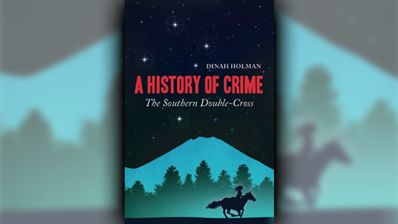Stephanie Jones: Book Review - A History of Crime by Dinah Holman
- Publish date
- Friday, 26 Sep 2014, 12:00AM

The fanciful and fascinating hijacking of the course of New Zealand history by “enemies of the colony” takes place in local writer Dinah Holman’s debut novel A History of Crime. Subtitled ‘The Southern Double-Cross’, the story, set in 1887, centres on a Maori-French-Anglo singer, Frédérique (Riki) Bonnell, who takes the opportunity presented by her status as the “new darling of London opera” to make her first visit to the homeland of her grandfather, who departed New Zealand in the 1830s with the explorer Dumont d’Urville.
‘Unwelcoming’ doesn’t begin to describe Riki’s first encounter with what Maori then referred to as Niu Tirani: she is rudely introduced to the South Pacific when, out on deck late at night as the ship approaches Auckland, she witnesses a man being flung into the water and, spotted by the assailants, finds herself following the stranger into the depths.
Each acts as the other’s saviour, and Riki learns that her new companion and soon-to-be ally, Kaituhi, is exploiting his facility in Maori and English by writing the ‘Chronicles’ for his Tuhoe iwi to record the widespread occurrence of land theft and bribery that is eroding his people’s holdings.
Kaituhi explains to a flabbergasted Riki that land speculators give Maori alcohol to weaken them and that powerful Pakeha are referred to by Maori as “friends in the dark” because of the secretive backchannelling that goes on between politicians, lawyers, police and other public officials seeking to enrich themselves at the expense of tangata whenua. Though cases are constantly before the land court, Maori are disadvantaged by a lack of funds and representation, and their petitions are always futile.
It’s a high-stakes game that a small cadre of Pakeha is winning, and Holman starts her story with an acorn of historical fact and spins it into a mighty and energetic page-turner of malfeasance and murder, with Riki as the dauntless Miss Marple who must get to the bottom of things. She is aided in her crusade by a handful of good folk, including an Italian fellow singer, Francesco Bartellin, with whom she tours New Zealand, ostensibly focused on artistic expression but secretly conducting an investigation that could bring down some of the country’s most powerful men.
Real characters and events are at issue: Thomas Russell was a lawyer and director of the Bank of New Zealand who leveraged his authority with the bank and its subsidiary to prop up his insolvent companies. His partner and one-time New Zealand Premier Sir Frederick Whitaker was in on the scam and a number of dubious deals that illegally wrested land from Tuhoe, as was Colonial Treasurer Sir Julius Vogel. These “extravagant money-men”, as one character describes them, provoked a widespread business depression that destabilized the young colony’s economy.
As the fictional tale begins, Russell has attempted to murder Kaituhi and Riki because of the former’s discovery of documents that point to Russell’s corruption, and I suspect that if Holman had pursued a purely factual version of events, the outcome for the reader would have been similarly shocking and dramatic. (Both versions, ideally, would include such endearing snapshots of history such as the Auckland Coffee Palace and the role of the Minister of Mines.)
Nevertheless, A History of Crime resounds with the ring of truth, greed and venality being tenacious elements of the human condition and today’s public discourse reminding us constantly of the need to redress the sins of the past.
Take your Radio, Podcasts and Music with you

